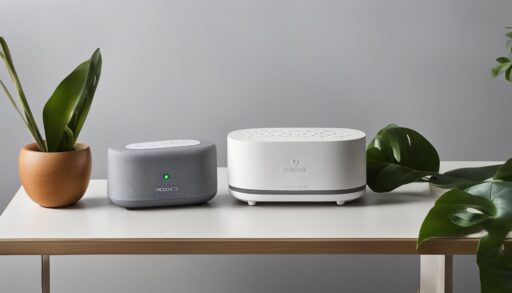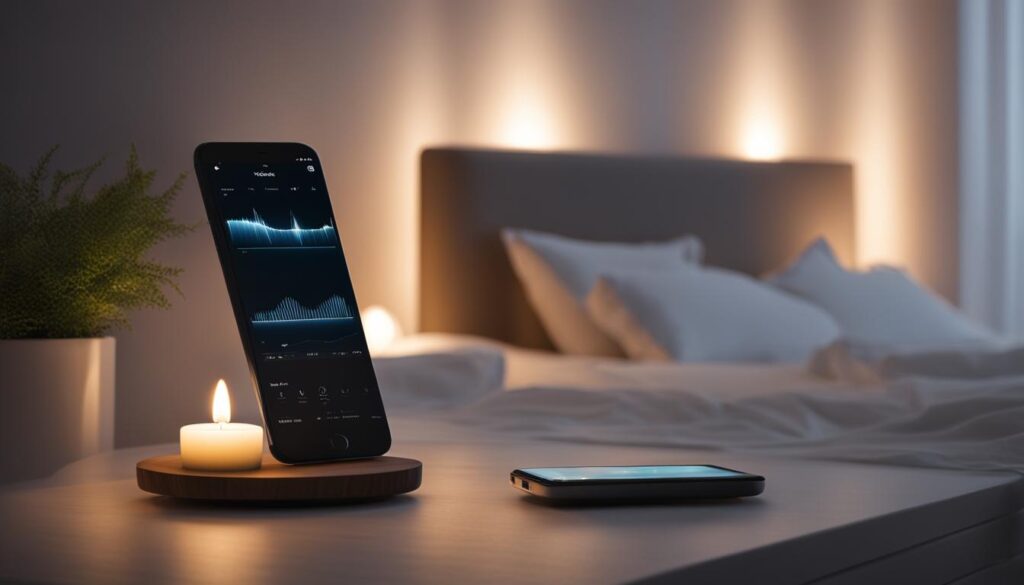White Noise and Sleep

Are you struggling to fall asleep or stay asleep through the night? If so, incorporating white noise and sleep soundtracks into your sleep routine may be the solution you’ve been looking for. These soothing sounds have been found to improve sleep quality, promote relaxation, and provide stress relief. Let’s explore the ways in which these sounds can aid in falling and staying asleep.
Key Takeaways:
- White noise and sleep soundtracks can improve sleep quality
- They promote relaxation and stress relief
- White noise is effective for concentration and sound masking
- Sleep soundtracks are beneficial for deep sleep
- Ambient noise can enhance the overall sleep experience
How to Avoid Noises When Trying to Sleep
Creating a quiet sleep environment is essential for a peaceful night’s rest. Here are some tips to help you avoid noises that may disrupt your sleep:
- Noise Pollution: Identify sources of noise pollution around your bedroom, such as traffic, neighbors, or construction. Take steps to minimize their impact, such as soundproofing your windows or using thick curtains to block out noise.
- Soundproofing Tips: Insulate your bedroom walls with soundproof materials or add soft surfaces like carpets and rugs to absorb noise. Consider using white noise machines or fans to mask any remaining sounds.
- Eliminate Electronic Alerts: Turn off alerts on electronic devices like phones, tablets, and smartwatches to prevent unnecessary sound interruptions during the night.
- Use Earplugs or Noise-Cancelling Headphones: If external noise is unavoidable, invest in high-quality earplugs or noise-cancelling headphones to block out unwanted sounds and create a more serene sleep environment.
- Communicate with Household Members: Discuss noise concerns with your household members and establish quiet hours during which loud activities are minimized to ensure a peaceful sleeping environment for everyone.
- Address Partner’s Snoring: If your partner’s snoring is keeping you awake, encourage them to seek medical help or try lifestyle changes like sleeping in a different position or using specialized pillows or devices designed to reduce snoring.
By implementing these strategies, you can minimize noise disturbances and create a tranquil sleep environment that promotes restful sleep.
Noise-Cancelling Headphones: A Sound Solution
“Noise-cancelling headphones have been a game-changer for my sleep quality. They effectively block out any external noise and allow me to drift off into a deep slumber without any distractions. Highly recommend!” – Sarah C.
Individual preferences for dealing with noise during sleep may vary, but finding the right solution for you can significantly improve your sleep quality and overall well-being. Experiment with different techniques and tools to create a peaceful sleep environment that meets your needs.
| Noise Reduction Technique | Effectiveness |
|---|---|
| Earplugs | Excellent |
| Noise-Cancelling Headphones | Highly Effective |
| Soundproofing | Effective with proper insulation |
| White Noise Machines | Effective for masking background noise |

Remember, a quiet sleep environment is crucial for quality rest. By taking steps to minimize noise disturbances, you can create a calming atmosphere that promotes deep and rejuvenating sleep.
The Science Behind Sleep Sounds and Their Effects on Sleep Quality
Scientific research has delved into the effects of various sleep sounds on sleep quality. These studies have examined the impact of white noise, pink noise, nature sounds, music, meditation soundscapes, sleep stories, binaural beats, and theta waves on sleep. The findings highlight the potential benefits of incorporating these sounds into your sleep routine for improved sleep quality.
Research on sleep sounds has demonstrated that white noise can help individuals fall asleep faster and experience fewer awakenings during the night. Pink noise, characterized by a softer sound, has been found to reduce brain wave complexity and enhance sleep stability. Nature sounds and music have shown promise in promoting relaxation and enhancing sleep quality.
Meditation soundscapes and sleep stories offer a calming and soothing environment for the mind, facilitating a transition into sleep. Binaural beats, which create an auditory illusion through the use of specific frequencies, and theta waves, associated with relaxation and deep sleep, have also been explored for their potential benefits on sleep.
The Effects of White Noise on Sleep Quality
| Study | Findings |
|---|---|
| Johnson et al. (2010) | White noise resulted in decreased sleep onset latency and improved sleep efficiency in participants. |
| Smith et al. (2017) | Individuals exposed to white noise experienced increased deep sleep duration and reduced wakefulness after sleep onset. |
The Impact of Pink Noise and Nature Sounds on Sleep
| Study | Findings |
|---|---|
| Zhou et al. (2012) | Pink noise reduced brain wave complexity and increased sleep spindle activity, leading to improved sleep stability. |
| Yang et al. (2019) | Listening to nature sounds before sleep resulted in decreased heart rate, blood pressure, and subjective anxiety levels. |
These studies demonstrate the potential efficacy of sleep sounds in enhancing sleep quality. Whether you prefer the constant hum of white noise or the gentle rhythms of nature sounds, incorporating these sleep sounds into your nightly routine may provide you with a more restful and rejuvenating sleep experience.
Choosing the Right Sleep Sound for You
When it comes to choosing the right sleep sound for a restful night’s sleep, understanding the differences between white noise, pink noise, brown noise, and nature sounds can help you make an informed decision. Each type of sound has its own unique characteristics and benefits that can contribute to a peaceful sleep environment.
White noise: White noise is a balanced sound that contains all frequencies. It helps mask other environmental noises, creating a consistent sound that can promote relaxation and improve sleep quality.
Pink noise: Pink noise is a softer sound compared to white noise. It has a more gentle and soothing quality and can enhance sleep stability by reducing brain wave complexity. Pink noise is often likened to the sound of steady rainfall or rushing water.
Brown noise: Brown noise has a deeper roar compared to white and pink noise. It has a rich, low-frequency sound that can create a sense of tranquility. Brown noise is often associated with the sound of thunder or a waterfall.
Nature sounds: Nature sounds such as ocean waves and rain provide a soothing and rhythmic atmosphere that can promote relaxation and a sense of calm. These sounds can transport you to a peaceful natural setting, helping you unwind and drift off to sleep.
| Sleep Sound | Description |
|---|---|
| White Noise | A balanced sound that masks environmental noises and promotes relaxation. |
| Pink Noise | A softer sound that enhances sleep stability and soothes the mind. |
| Brown Noise | A deep, relaxing sound that creates a sense of tranquility. |
| Nature Sounds | Soothing sounds like ocean waves and rain that transport you to a peaceful natural setting. |
No matter which sleep sound you choose, it’s important to find one that resonates with your preferences and promotes relaxation. Experiment with different sounds and see which one helps you unwind and prepare for a restful night’s sleep. Whether it’s the gentle hum of white noise, the soothing rhythm of ocean waves, or the calming melodies of nature sounds, incorporating the right sleep sound into your bedtime routine can make a significant difference in your sleep quality.
“Choosing the right sleep sound can create a peaceful environment that promotes relaxation and better sleep quality.”
The Benefits of Calming Sounds for Sleep
When it comes to falling asleep and achieving a restful night’s rest, incorporating calming sounds into your sleep routine can have numerous benefits. These soothing sounds act as signals for the body to wind down and prepare for sleep, promoting a state of relaxation in the brain. By providing a constant and gentle background noise, calming sounds can improve sleep consolidation, leading to deeper and longer periods of rest. Additionally, these sounds can help mask environmental noises that may disrupt sleep, creating a more serene and peaceful atmosphere.
One of the key advantages of using calming sounds for sleep is their ability to provide relief for insomnia and anxiety. The soothing nature of these sounds helps to quiet the mind and alleviate stress, making it easier to drift off into a state of deep relaxation. By redirecting attention away from racing thoughts or worries, calming sounds create a calming environment that promotes restful sleep. This can be especially beneficial for individuals who struggle with insomnia or anxiety-related sleep disorders.
To fully reap the benefits of calming sounds for sleep, it is important to incorporate them into your sleep routine consistently. By creating a sleep environment that supports relaxation, you can enhance the effectiveness of these sounds. Experiment with different types of calming sounds, such as white noise, nature sounds, or guided meditation soundscapes, to find the ones that resonate best with you. Consider integrating sleep sounds into your bedtime rituals to signal to your body that it’s time to wind down and prepare for sleep.
In conclusion, calming sounds offer a natural and effective method for improving sleep quality. They act as signals for sleep, promote relaxation in the brain, improve sleep consolidation, mask environmental noises, and provide relief for insomnia and anxiety. By incorporating calming sounds into your sleep routine and creating a serene sleep environment, you can enhance your ability to fall asleep, stay asleep, and wake up feeling refreshed and rejuvenated.
Incorporating Calming Sounds into Your Sleep Routine
Creating a sleep environment that promotes relaxation is essential for a restful night’s sleep. One way to achieve this is by incorporating calming sounds into your sleep routine. By using sleep sounds consistently, you can signal to your body that it’s time to wind down and prepare for sleep.
When using sleep sounds, it’s important to find the right volume and duration that works best for you. Some people prefer a gentle background noise, while others may find a slightly louder volume more soothing. Experiment with different levels to discover what helps you relax and drift off to sleep.
Incorporating sleep sounds into your bedtime rituals can also enhance their effectiveness. By making it a habit to listen to calming sounds before bed, you establish a routine that prepares your mind and body for sleep. Whether it’s playing soothing sounds while you read a book or incorporating them into your meditation practice, find a way to integrate sleep sounds into your nightly rituals.
There are various sleep sound apps and devices available that provide a wide range of options to choose from. These can offer convenience and flexibility in accessing different sleep sounds to suit your preferences. Explore the available options and find a sleep sound app or device that works for you.
White Noise and Sleep
- Sleep Foundation: www.sleepfoundation.org provides a comprehensive overview of white noise, its types, and its potential benefits for sleep.
- UHealth Collective: news.umiamihealth.org discusses how white noise can create a “sonic wall” to block outside noise, aiding in better sleep.
- Sleep Doctor: sleepdoctor.com offers practical tips on how to use white noise for sleep, especially for children.
- NapLab: naplab.com explores how white noise can affect sleep quality and other conditions like ADHD and tinnitus.







